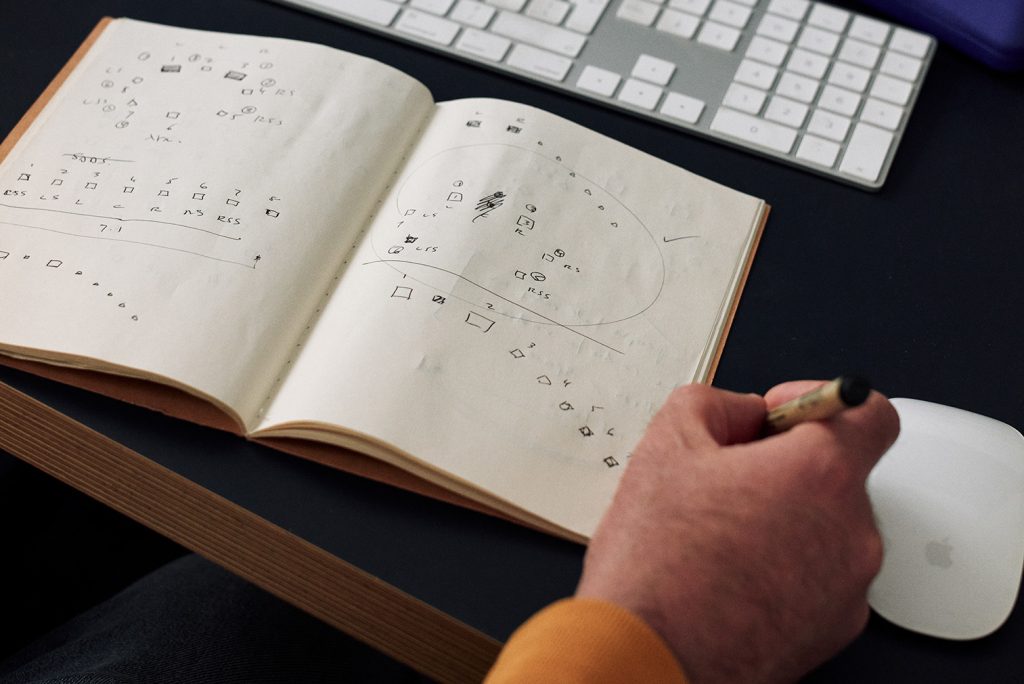He’s an artist, composer and, as of last September, an Emmy-winning sound designer (for work on the documentary Fathom). But until six years ago Nick Ryan worked out of his living room, in a flat that contained only a bed and a desk.
The ability to toil in spartan conditions might have helped him when Jonathan Reekie, director of the 200-year-old urban palace Somerset House, began to redevelop the New Wing as a centrifuge for creativity. ‘It was a bit of an experiment at the time – it still is,’ says Ryan, speaking of the leaky roof, the vermin and the ‘famously old’ carpet, still covering a stretch of corridor. ‘Gradually, he put word out and got artists open to it being rough.’
Ryan’s application was approved – likely on the merit of 2016’s Project Adrift, in which he tracked the movement of debris through space (‘space junk’) and programmed a machine to emit a snippet of original composition whenever a fragment passed overhead.
He was and still is the only sound artist in this studio city of close to 80, surrounded not by canvases or unfinished sculpture but speakers, cables and a 90cm horizontal monitor for visualising long sound waves. A tiny keyboard teeters on a stack of stuff in one corner; Ryan uses it, and a guitar when he composes for TV. There’s not a great deal to help a visitor visualise a body of work that has become increasingly more political and more complex.

Photography: Kane Hulse

Photography: Kane Hulse

Photography: Kane Hulse

Photography: Kane Hulse

Photography: Kane Hulse

Photography: Kane Hulse

Photography: Kane Hulse

Photography: Kane Hulse

Photography: Kane Hulse
‘When I came here, I was exploring the paradox of listening as I see it – fascinating but immaterial sensory experiences,’ he says. ‘But the tactility of imagined sound is something I wanted to materialise.’ How to produce an audio ‘canvas’ was a skill made achievable by virtue of being in the Somerset incubator, a community founded on inclusivity and freedom from prejudice. Ryan calls the network of independent workshops, spanning vitrines of art, shared kitchen and billiard room ‘very much a safe space’ for the free exchange of ideas and advice. Often he keeps his door open, a physical cue to encourage queries and solicitations.
When the BBC commissioned his proposal to commemorate the centenary of its first-ever radio transmission (from Marconi House, up the road) through sound, Ryan had to learn to fabricate a pathway of sounding posts: customised standing speakers to install along a recently pedestrianised stretch of The Strand. He spent months at Makerversity, Somerset House’s in-house factory, trough below street level brought back from dereliction with a 3D printing facility and wood shop. This is where he taught himself machining, 3D printing and steel bending. What emerged were 39 bespoke brass boxes encircled by a perfect ring of steel. Within the boxes, sophisticated L-Acoustics 5XT coaxial speakers would layer archival moments, storytelling and atmospheric recordings, rotated at a walker’s pace. The sounds and motion would trigger light from the ring, like a staircase in a Hollywood dance sequence.

‘My proposition used digital technology to create a public space that can shape and change sound in real time,’ he says, comparing VoiceLine, as he called it, to orchestrated synaesthesia. It temporarily transformed a notoriously clamorous 170-metre walk into an edifying soundscape with a physical form.
‘I was thrilled with the idea of presenting sound as a piece of municipal infrastructure,’ he says. ‘We tend to think of infrastructure as street furniture, architecture, lighting, landscaping… but sound is important to the flow, and the sound most audible here is normally collateral from traffic.’
In several broadcasts, he relied on the software suite L-ISA Studio to give him control over panning and reverb. ‘VoiceLine is basically the unfolding of an immersive system into a line, and L-ISA Studio helped make the experience seamless. The idea was to create a “bubble of sound” that overlaps each subsequent bubble of sound.’ With speakers positioned in a crisscross fashion and sound played at a relatively low level, there was no break in linearity. The fixed points of each speaker became imperceptible.
The process, says Ryan, was ‘like art school, for adults’. The upshot, however, is that this sound studio is now a repository for the literal nuts and bolts of making.
‘It’s not quite big enough.’

























